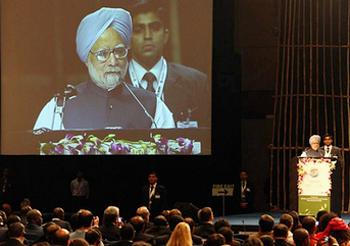 印度總理曼莫漢‧辛格16日宣布,將在接下來兩年內投資5千萬美元,加強保育生物多樣性與地球繽紛的生命。
印度總理曼莫漢‧辛格16日宣布,將在接下來兩年內投資5千萬美元,加強保育生物多樣性與地球繽紛的生命。
這筆款項名為「海德拉巴誓言」,在印度擔任193國政府參與的《生物多樣性公約》輪值主席的2年內,挹注於印度的生物多樣性保育,另外也會投入其他缺乏保育資金的發展中國家,改善其物種保育、遏止盜獵、拯救棲地喪失及污染防治等工作。
辛格向出席生物多樣性公約第11次締約方大會的各國領袖致詞時,呼籲加強全球合作,並表示即便本會議自10月8日召開以來進行的物種保育談判遭遇許多困難,他仍對此次會議保持信心。
他表示,「近年來,在環境議題上越來越難得到共識;事實上,這導致現今全球高升的環境風險意識和關注。即便在全球經濟衰退的壓力下,這種意識應驅使我們採取更多的行動。人們應該瞭解保護生物多樣性的重要性,地球上繽紛的生命是自然界百萬年來為了因應外在環境變化的結果;我們必須在災難來襲前同心協力採取行動。」「在我們的國家,保護和促進生物多樣性一直是我們民族精神和文明的一部分;由全國各地無數受保護的林地可見一斑。我們傳統的農業和醫藥系統都仰賴動植物多樣性。保護我們所使用的自然資源野外原始品系對我們是非常重要的。」
辛格也指出,印度境內目前復育的動物有瀕危的大象、雪豹、獅子及老虎。從2006年到2010年,印度境內的老虎數量從約1411隻上升到約1706隻。
 除了這些高知名度哺乳動物的復育計劃,印度亦致力於傳統作物和種子的保存。總理表示:「關鍵在於如何調度必需的財政,技術和人力資源,特別是技術的培養、分享及轉移。印度承諾與所有伙伴達成愉快的共識,確保生態及經濟的永續成長。」
除了這些高知名度哺乳動物的復育計劃,印度亦致力於傳統作物和種子的保存。總理表示:「關鍵在於如何調度必需的財政,技術和人力資源,特別是技術的培養、分享及轉移。印度承諾與所有伙伴達成愉快的共識,確保生態及經濟的永續成長。」
印度環境與森林部長Jayanthi Natarajan在海德拉巴會議開幕時表示,最迫切的需求是「近年來生物多樣性喪失的趨勢,導致我們更接近生態系服務功能降低而影響我們生存的災難性臨界點。」
失敗陰影籠罩會議
海德拉巴會議籠罩在失敗的陰影中,各國並未達成2000年於約翰尼斯堡召開大會時設立的目標:10年內減緩物種喪失。
在2010年於日本愛知縣名古屋召開召開的上一屆大會,由於生物多樣性的喪失是如此明顯,各國設立了另一個10年目標來試圖控制迅速的滅絕。
該次會議中各國政府達成共識,就保護生物多樣性提出了20項目標,稱之為「愛知目標」,並有兩項補充協定,期望10年內減緩生物多樣性喪失。
愛知目標要求最遲在2020年前:
- 保護已知受威脅物種不致滅絕,並改善他們的保育現狀,尤其是那些急遽下降的物種。
- 保護至少17%的陸域水體、10%的海洋環境,尤其是在生物多樣性及生態系服務特別重要的區域。
- 削減或改革有害生物多樣性的津貼、發展的積極的獎勵措施保育和永續利用生物多樣性
- 將自然棲地(包括森林)喪失率減半,若可能的話希望能將喪失率降至零。
- 合法、永續的利用及管理漁業、無脊椎動物、水生植物等資源。
「生物多樣性公約」協議
2010年通過了名古屋議定書,期能保障生物遺傳資源利益的公平分配。確保透過遺傳資源技術合作,考量所有資源與技術的權益,達到獲利的目的。
上週,印度成為第七個批准名古屋議定書的國家;將於交付批准書90天後開始生效。
 另外一個新的協議是在2000年起推動「卡塔赫納生物安全議定書」(Cartagena Protocol on Biosafety)的新增條款,新的條款保護生物多樣性免於近代基因轉移技術引起的風險;它採取「審慎的態度」並在各國引入基因改造活體至該國前建立事前確認程序。
另外一個新的協議是在2000年起推動「卡塔赫納生物安全議定書」(Cartagena Protocol on Biosafety)的新增條款,新的條款保護生物多樣性免於近代基因轉移技術引起的風險;它採取「審慎的態度」並在各國引入基因改造活體至該國前建立事前確認程序。
2010年,各國通過「名古屋‧吉隆坡議定書」,它訂定國際規範及關於基因改造活體對生物多樣性產生的損害的賠償責任和補救程序。
印度政府將餘位來兩年擔任履行大會協定(包含生物多樣性策略目標及愛知多樣性目標)的主席工作。
環境部Natarajan部長表示:「我們不該受到現今全球經濟危機的阻撓,此局勢反而鼓勵我們投資於改善自然承載力,以確保所有地球生物依賴的生態系服務持續提供。」
她引述「印度之父」甘地的話語:「我們做了什麼、和我們有能力做什麼之間的差異足以解決世上多數的問題。」
在今年大會的高層峰會中,各國領袖將考慮四個主題並試圖訂定符合生物多樣性公約目標的策略。
- 在生計和消滅貧窮下的生物多樣性
- 2011-2020年生物多樣性策略計劃的施行
- 海岸及海洋生物多樣性
- 名古屋議定書的施行:使用遺傳資源及獲利共享
為了募集資金以實現愛知目標,印度和生物多樣性公約秘書處邀請各國政府加入公約締約國,並邀請其他利益相關者成為生物多樣性衛士(Biodiversity Champions)成員。
在投資5千萬美元後,印度成為第一個生物多樣性衛士。
India will invest US$50 million over the next two years to strengthen conservation of biological diversity, the variety of life on Earth, Prime Minister Manmohan Singh announced today.
Called the Hyderabad Pledge, much of the $50 million will be invested in India during its current two-year presidency of the Convention on Biological Diversity, CBD, an international treaty with 193 governments participating.
India will share some of this funding with other developing nations struggling to fund conservation efforts as species slip away – victims of poaching, habitat destruction and pollution.
Speaking to world leaders gathered for the 11th biannual meeting of the Convention, Prime Minister Singh urged greater global cooperation and expressed confidence that the negotiations underway in Hyderabad since October 8 would protect species despite the many difficulties.
“In recent years, it has become increasingly more difficult to find common ground on environmental issues,” said Singh. “This is, indeed, unfortunate given that there is today a much higher global awareness of environmental risks and concerns. It is this consciousness that should provoke us to greater action even as we cope with the pressures of the current global economic downturn.”
“Humankind should understand the importance of preserving biodiversity,” the Prime Minister said. “The diversity of life forms on Earth is the culmination of millions of years of the productive genius of nature. It is nature’s insurance against extreme events that may disturb the delicate balance of this planet. We need to work together and act before a catastrophe is upon us.”
“In our country,” said Singh, “protecting and promoting biodiversity has always been an integral part of our ethos and our civilization. This can be seen in the thousands of sacred groves that are found all over the country. Our traditional systems of agriculture and medicine depend on plant and animal biodiversity. Conserving the wild ancestors and relatives of the cultivars we use today is of paramount importance to us.”
India is inhabited by endangered elephants, snow leopards and lions as well as tigers, which are in recovery. In 2010, the country level status assessment for tigers showed an increase in their number to an estimated 1,706 from an estimated 1,411 in the year 2006, Prime Minister Singh told conference delegates.
In addition to recovery programs for these high-profile mammals, India is working to conserve traditional varieties of crops and seeds.
“The critical issue really is how to mobilize the necessary financial, technical and human resources, particularly the incubation, sharing and transfer of technology,” the Prime Minister said. “India stands committed to work with all parties to reach the happy compromise that will secure a future that provides ecological and economic space for each one of us and sustainable growth for all of us.”
The need is urgent, said India’s Environment and Forests Minister Jayanthi Natarajan at the opening of the Hyderabad conference. “Current trends in biodiversity loss are bringing us closer to potential tipping points that would catastrophically reduce the capacity of ecosystems to provide services essential for our survival,” she warned.
The Hyderabad conference is taking place under the shadow of failure. World leaders failed to meet their goal of slowing the loss of species by 2010, agreed ten years earlier at the 2000 World Summit in Johannesburg.
At the last CBD conference in 2010 in Japan, when it became obvious that the loss of biodiversity was still accelerating, governments gave themselves another 10 years to gain control of runaway extinctions.
The Aichi Targets
The last CBD conference was held in October 2010 in the city of Nagoya, in Japan’s Aichi prefecture.
There, governments adopted a new Strategic Plan for Biodiversity, 20 new targets – called the Aichi Targets – and two new supplementary protocols to the Convention, setting the course for halting biodiversity loss by the end of the current decade.
By 2020, at the latest, among other measures, the ambitious Aichi Targets call for:
- preventing the extinction of known threatened species and improvement of their conservation status, particularly of those most in decline
- conservation of at least 17 percent of terrestrial and inland water, and 10 percent of coastal and marine areas, especially areas of particular importance for biodiversity and ecosystem services
- the elimination or reform of subsidies harmful to biodiversity and the development of positive incentives for the conservation and sustainable use of biodiversity
- halving the rate of loss of all natural habitats, including forests and, where feasible, bringing the rate of loss close to zero
- legal, sustainable harvesting and management of all fish and invertebrate stocks and aquatic plants
The CBD Protocols
Adopted in 2010, the Nagoya Protocol aims at a “fair and equitable” sharing of the benefits arising from the utilization of genetic resources. It ensures access to genetic resources and transfer of technologies, taking into account all rights over those resources and to technologies. And it provides for the funding of benefit sharing.
Last week, India became the seventh country to ratify the Nagoya Protocol, which will enter into force 90 days after the date of deposit of the 50th instrument of ratification.
The other of the two new protocols is an addition to the Cartagena Protocol on Biosafety adopted in 2000, which protects biological diversity from the risks posed by living genetically modified organisms created by modern biotechnology. It takes a “precautionary approach” and establishes an advance informed agreement procedure before countries import living modified organisms into their territory.
In 2010, governments adopted the Nagoya – Kuala Lumpur Supplementary Protocol to the biosafety protocol. It provides international rules and procedures on liability and redress for damage to biodiversity resulting from exposure to living modified organisms.
During its term of presidency, from 2012 until 2014, the government of India will preside over the implementation of the work of the Convention, including the Strategic Plan for Biodiversity and its Aichi Biodiversity Targets.
Environment Minister Natarajan said, “The present global economic crisis should not deter us, but on the contrary encourage us to invest more towards amelioration of the natural capital for ensuring uninterrupted ecosystem services, on which all life on Earth depends.”
She quoted the “Father of India,” Mahatma Gandhi, who said, ‘The difference between what we do and what we are capable of doing would suffice to solve most of the world’s problems.’”
During the High Level Segment of this year’s conference, world leaders will consider four themes and try to develop strategies to accomplish the CBD goals:
- Biodiversity for Livelihoods and Poverty Reduction
- Implementation of the Strategic Plan of Biodiversity 2011-2020
- Coastal and Marine Biodiversity
- Implementation of the Nagoya Protocol on Access to Genetic Resources and Benefit Sharing
To raise the money to achieve the Aichi Biodiversity Targets, India and the CBD Secretariat are inviting government Parties to the Convention and other stakeholders to become Biodiversity Champions.
With her $50 million contribution, India today became the first Biodiversity Champion.
※ 全文及圖片詳見:ENS





